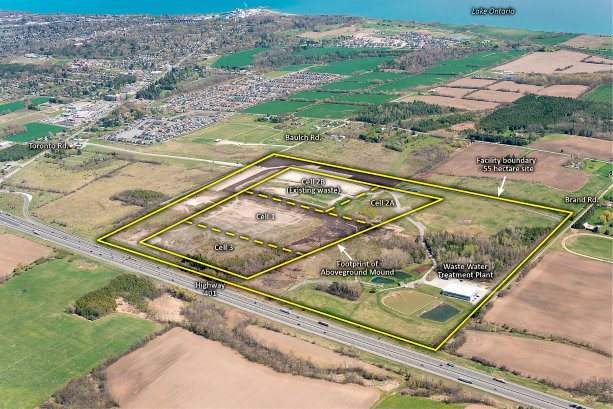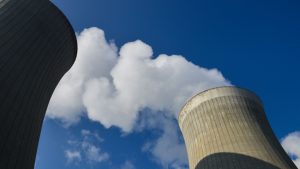The latest milestone in long-running efforts to find safe storage for decades-old low-level radioactive waste (LLRW) generated in Port Hope, Ont. was reached last month as government and community partners broke ground on a new, and final, LLRW storage facility.
Emphasis is on worker and community safety, say stakeholders, as the Port Hope Area Initiative Management Office (PHAI MO), led by Canadian Nuclear Laboratories (CNL), overseas the project on behalf of Atomic Energy of Canada Limited, a federal Crown corporation.
The federal government committed $1.28 billion to pay for permanent storage facilities in Port Hope and nearby Port Granby in 2012.
Widespread LLRW contamination of the Port Hope townsite resulted from lax disposal practices by Eldorado Gold Mines and its successors under different names beginning in 1932, when it opened radium refining facilities in Port Hope, through to the 1970s. A PHAI website timeline notes that during that period, "Properties and sites in the Town of Port Hope become contaminated from spillage during transportation, unrecorded, unmonitored or unauthorized diversion of contaminated fill and materials, wind and water erosion and spread from residue storage areas."
CNL engineers say construction of homes many decades ago would have been undertaken using truckloads of contaminated fill.
The LLRW consists of "predominantly soil, contaminated with uranium, radium-226, thorium-230 and arsenic," a CNL spokesperson said.
The Government of Canada took over Eldorado in 1944. Initial remediation efforts by the Atomic Energy Control Board began in 1976. The PHAI was established in 2001.
Senior project managers from CNL say the construction of the two LLRW storage facilities — called long-term waste management facilities (LTWMF) — brings a responsibility to consult with the community and other stakeholders and regulators, but otherwise the builds are typical of many others undertaken across the continent where waste materials must be safely stored.
CNL officials say, however, that the residential property remediation process in Port Hope injects an added dimension to that project, as an estimated 375 Port Hope property owners may face potentially extensive property excavations starting in 2018. As part of the PHAI project management plan, 4,800 Port Hope homes and properties are being surveyed for LLRW. The PHAI website indicates it is expected that one-tenth or fewer of those properties will require remediation.
CNL project director Bryan Tyers and CNL manager of technical integration Walter van Veen described how the harvesting of the LLRW would proceed at those properties.
"In most cases it is going to be a few feet, maybe up to a metre," van Veen said. "It is rarely going to be below the footing depth of the property. The footing depth is typically about 1.2 to 1.3 metres, so we are looking at excavations that are less than that."
The five-phase surveying of properties, under a program called the Port Hope Project Property Radiological Survey, began last year. The firm ARCADIS, under contract with the PHAI, began that work in September. Van Veen suggested a typical excavation job might require a small rubber-tired backhoe or larger track excavator, depending on access, and there might be 50 to 100 cubic metres of soil removed from a property, enough to fill five or 10 trucks. Trucks would be tarped tightly and decontaminated if necessary before leaving the property, he said.
PHAI communications officer Bill Daly was asked if PHAI property remediation might require demolition of homes in some cases. He replied, via email, that remedies would depend on the extent and location of LLRW at each property and that restoration agreements signed with homeowners could include "landscaping or reconstruction activities."
Port Granby is located 15 kilometres east of Port Hope and the remediation project there is much simpler because it is merely a matter of transferring waste from one rural property to another 700 metres north, Daly noted. The LLRW originated from the Eldorado operations in Port Hope.
An $86.8-million contract awarded to AMEC-CB&I Joint Venture last year enabled the launch of excavation activities at the Port Granby site. The construction of Port Granby’s 450,000-cubic-metre above-ground LTWMF is expected to be complete within two years.
Tyers said he has been attending work at Port Granby this summer and described it as a busy site, with bulldozers, excavators, surveyors, field engineers, quality assurance specialists, safety and radiological specialists and skilled trades including electrical and mechanical workers active on site.
Over at Port Hope, the PHAI expects its excavation efforts at the contaminated Port Hope properties, and at other identified "known sites," to yield approximately 1.2-million cubic metres of LLRW. For contingency reasons the Port Hope LTWMF will be built to accommodate 2-million cubic metres of LLRW.
Some of the sites identified include the former St. Mary’s School, Caroline Street Park and the Peter Street Interim Storage Mound. A total of 175 roadways were also identified for testing.
The work will be undertaken by ECC/Quantum Murray LP of Toronto, a landfill construction and environmental remediation company.
The LTWMF will be located south of Highway 401 west of Baulch Road in Port Hope; it’s a site that already had contaminated soil, so part of the job required the contractor to first relocate the on-site LLRW within the property boundaries.
Construction of the LTWMF is expected to be complete in late 2017, with delivery of LLRW beginning in 2018 and continuing over five years, when the mound is expected to be closed. Other work as part of the PHAI contract will include remediation at the Lake Ontario waterfront, at Port Hope Harbour, on Highland Drive and at other industrial sites up to 2021.






Recent Comments
comments for this post are closed